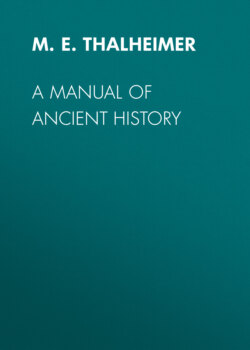Читать книгу A Manual of Ancient History - M. E. Thalheimer - Страница 43
BOOK II.
The Persian Empire from the Rise of Cyrus to the Fall of Darius.
BC 558–330.
Оглавление1. About 650 BC, a warlike people, from the highlands east of the Caspian, took possession of the hilly country north of the Persian Gulf. They belonged, like the Medes, to the Aryan or Indo-Germanic family, and were distinguished by a more hardy, simple, and virtuous character, and a purer faith, from the luxurious inhabitants of the Babylonian plains. The nation, as it soon became constituted, consisted of ten tribes, of whom four continued nomadic, three settled to the cultivation of the soil, and three bore arms for the general defense. Of these the Pasar´gadæ were preëminent, and formed the nobility of Persia, holding all high offices in the army and about the court.
2. The first king, Achæ´menes, was a Pasargadian, and from him all subsequent Persian kings were descended. For the first hundred years of its history, Persia was dependent upon the neighboring kingdom of Media. But a little after the middle of the sixth century before Christ, a revolution under Cy´rus reversed the relations of the Medo-Persian monarchy, and prepared the foundations of a great empire which was to reach beyond the Nile and the Hellespont on the west, and the Indus on the east.
3. Cyrus spent many of his early years at the court of Asty´ages, his maternal grandfather, in the seven-walled city of Ecbat´ana.[21] The brave, athletic youth, accustomed to hardy sports and simple fare, despised the wine and dainty food, the painted faces and silken garments of the Median nobles. He saw that their strength was wasted by luxury, and that in case of a collision they would be no match for his warlike countrymen. At the same time, a party of the younger Medes gathered around Cyrus, preferring his manly virtues to the effeminate pomp and cruel tyranny of their king, and impatient for the time when he should be their ruler.
